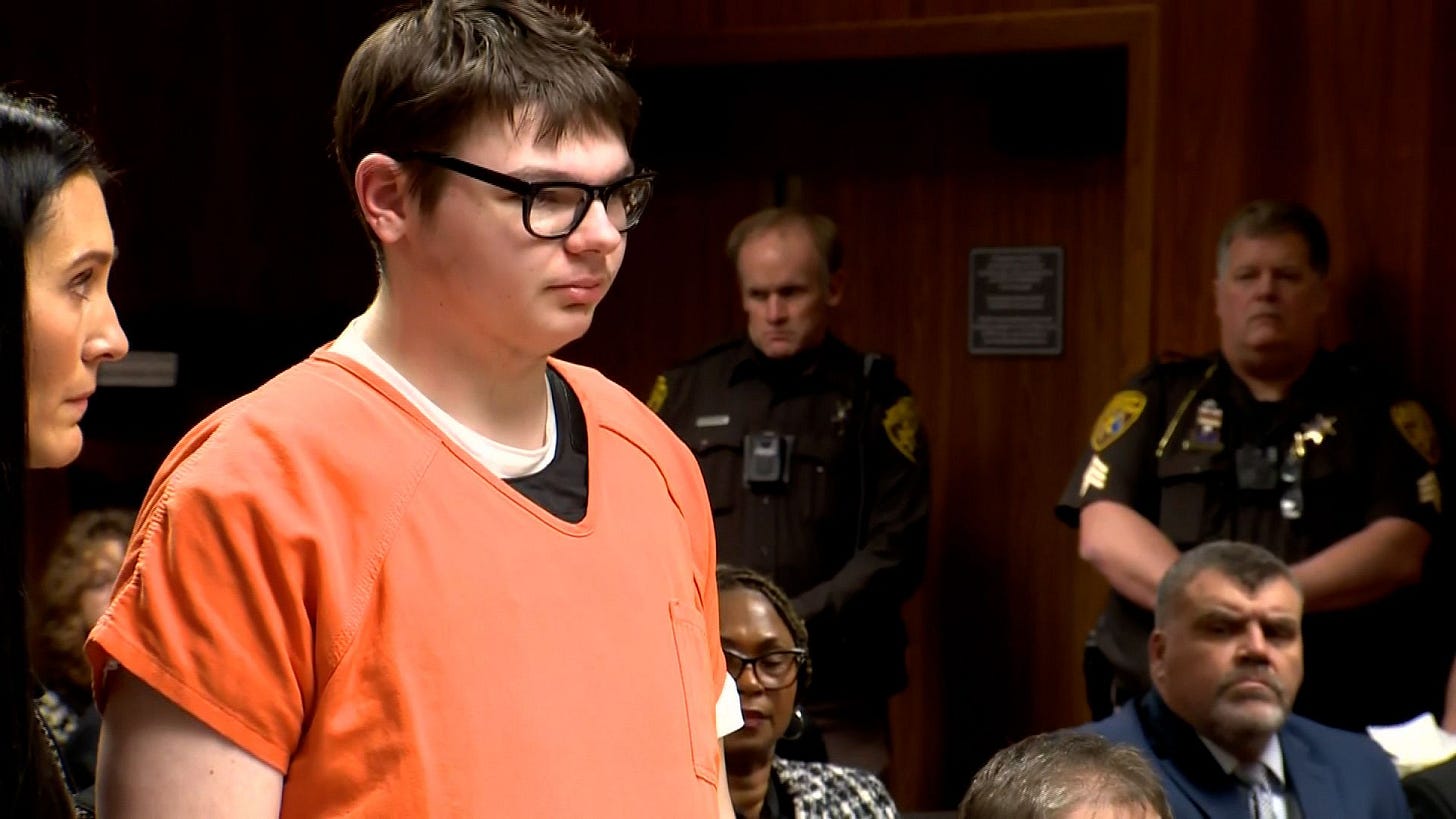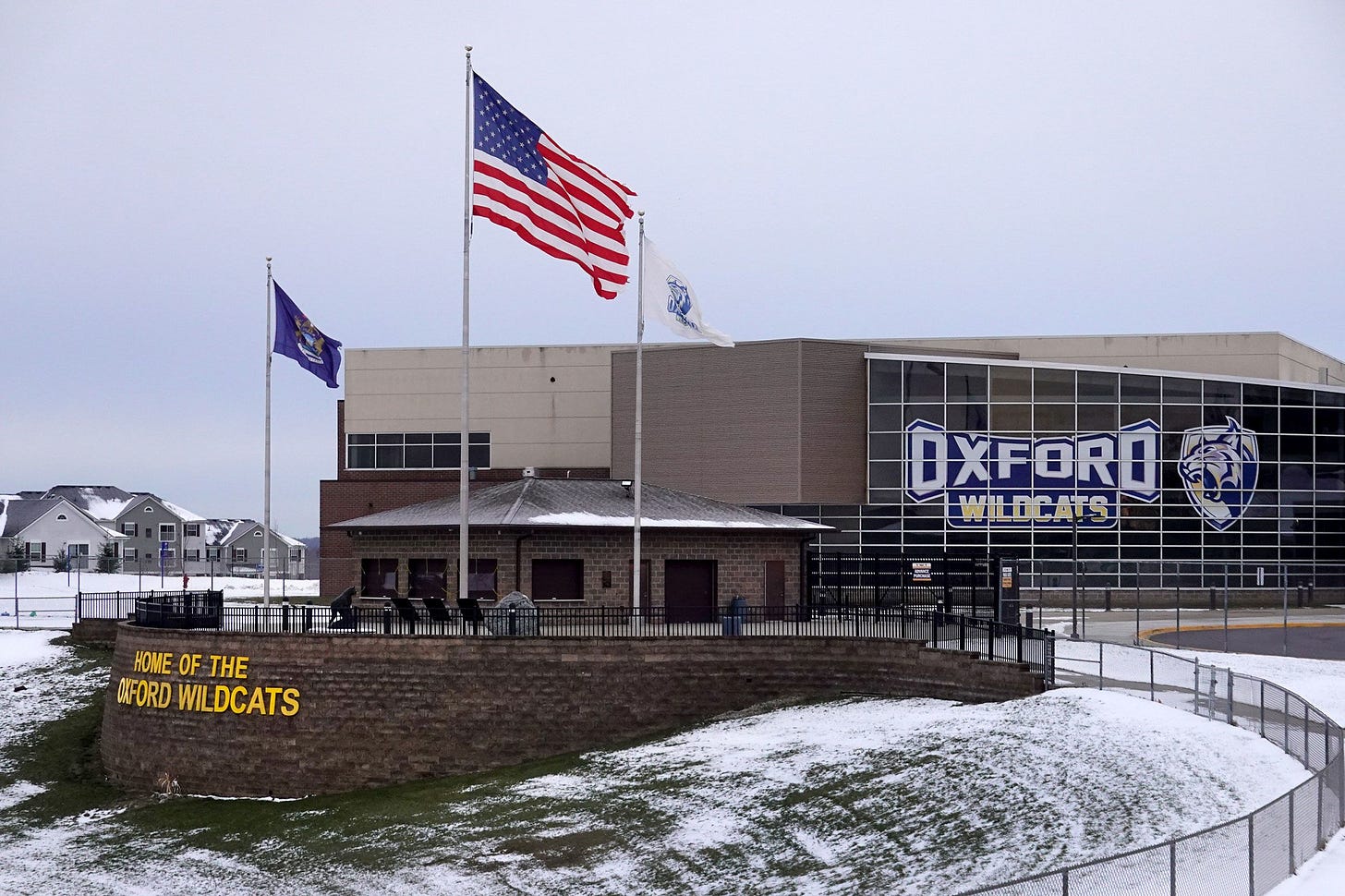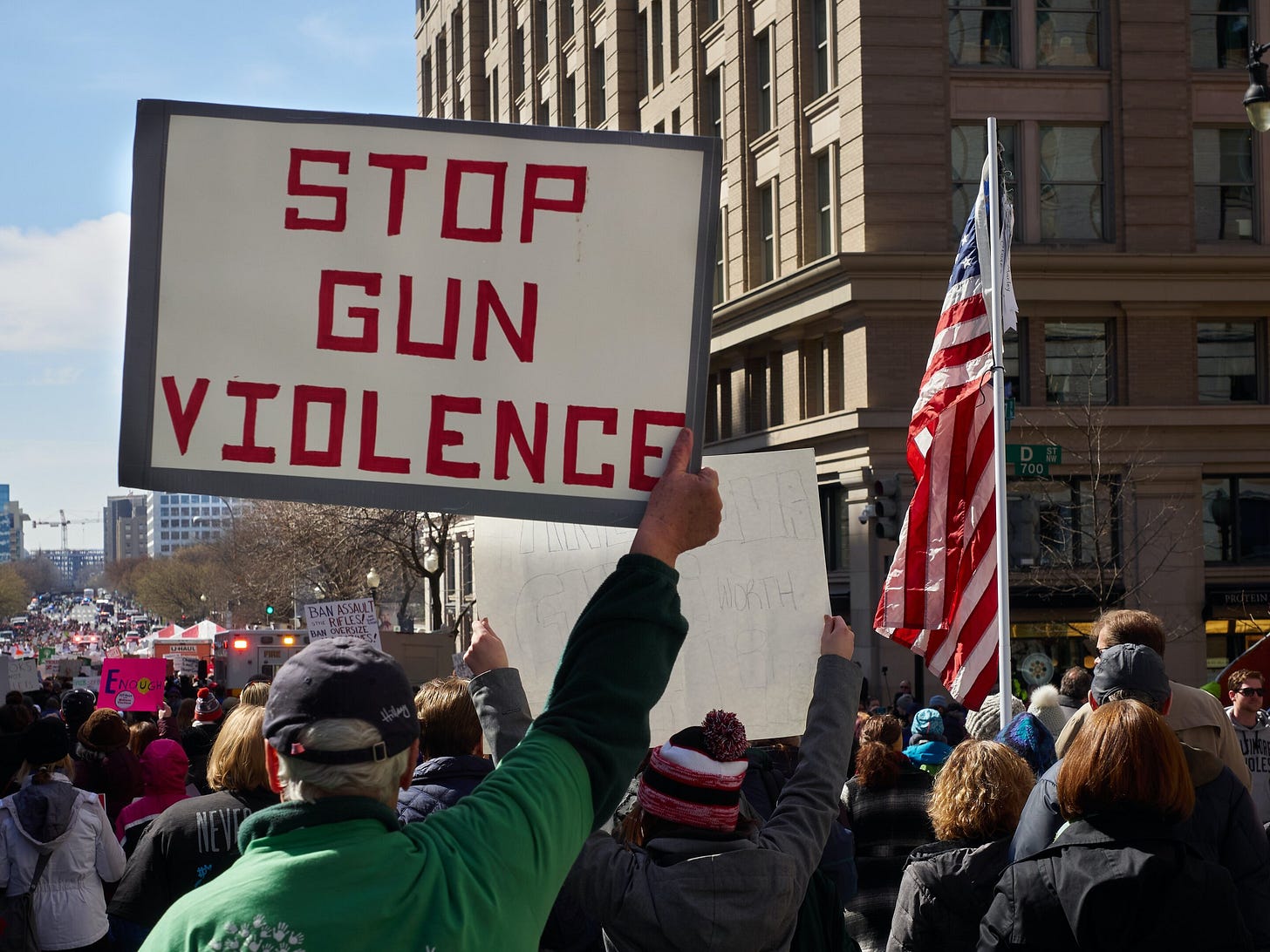Paying By The Bullet - The Cost of Bearing Arms
The Balance of Gun Ownership & Legal Liability
In Michigan, the Oxford High School shooter, fifteen-year-old Ethan Crumbley, was found guilty of murdering four students. He was sentenced to life in prison without the possibility of parole on December 9, 2023. [1]
His parents, James and Jennifer Crumbley, were also later charged and ultimately found guilty of manslaughter. They had bought their underage son a firearm—the very weapon Ethan used in the shooting, and prosecutors argued that they did not properly store it. Ethan testified that the gun wasn’t locked up, and was easy to access and put in his backpack the morning of the shooting. Prosecutors also said that the couple failed to act on signs of their son’s declining mental health—an evidenced fact made worse by the boy’s easy access to a gun. Including a drawing on a math paper depicting a gun, a bullet and a wounded man with the words, “The thoughts won’t stop. Help me. Blood everywhere. My life is useless.” The gun drawn on the paper also reportedly looked eerily similar to the one his parents bought him, a Sig Sauer 9mm. [2] This was found the day of the shooting, and the school held a meeting with James and Jennifer that lasted less than fifteen minutes. The school staff were surprised when the parents didn’t want to take their child home, and instead ended up giving them some resources to find help for their son, as the parents wanted to return to work. School staff would state that the parents of the troubled boy seemed fairly unconcerned about the drawing. The Crumbleys became the first parents to be convicted of a crime connected to a school shooting their child committed.
In Georgia, fourteen-year-old Colt Gray was charged for a school shooting at Apalachee High School, where the teen allegedly killed two students, two teachers, and injured a further nine people. His father, Colin Gray, has been charged with four counts of involuntary manslaughter, two counts of second degree murder, and eight counts of cruelty to children, according to the Georgia Bureau of Investigation. [3] Becoming the second time a parent has been charged in America for a crime connected to a school shooting their child committed. If found guilty on all counts, he could face up to 180 years in prison. Colin Gray, prosecutors have argued, recklessly supplied his underage son with a firearm, and failed to appropriately store that firearm, with knowledge that his son was a threat. Colt had made a post on social media a year prior threatening to shoot up his school. When law enforcement initially responded to this threat, there wasn’t enough evidence to prove that Colt had made the post. Colin assured investigators that his son understood the importance of gun safety, and that he wasn’t a danger to the school.
These are landmark cases, especially the conviction and sentencing of Ethan Crumbley’s parents. Parents of a school shooter had never been convicted of crimes relating to their child’s shooting, until the Crumbleys, and now Colin Gray may also be convicted of similar crimes. It’s interesting that the Crumbleys and Mr. Gray were all three charged, in part, specifically for how they stored a firearm. The conviction of James and Jennifer, alongside Colin if he is convicted, could set a legal precedent. Though the potency of its effects remains to be seen, I think it raises some important points regarding gun law in this country. The two cases also highlight a shifting paradigm, in both legal and public perception of the role parents may play in school shootings. When the Columbine Massacre occurred in 1999, many people were quick to dismiss any alleged fault on the part of the shooters’ parents. In retrospect, having more footage, documents and interviews in the public domain—and a book written by Sue Klebold, mother of Dylan Klebold, one of the Columbine shooters, called, “A Mother’s Reckoning: Living in the Aftermath of Tragedy”, where she describes possible signs and motives she had missed from Dylan—we can see how there were a plethora of signs that stuck out like a sore thumb; signs from both of the shooters that could’ve prevented the massacre, if they were acted upon. The question then still remains: can parents prevent school shootings? And how much liability should parents have when their child shoots up a school?
The correlation between private citizen gun ownership—and firearm related homicides is strong, in America [4] and in the rest of the developed world. [5] [6] We are without a doubt the country with the most school shootings, and mass shootings in general. [8] [9] For high income countries, we are also the country with the least restrictive gun laws. The Second Amendment of the U.S. Constitution is largely the reason for more relaxed laws and regulation concerning firearms. As from this amendment to our country’s foundational document, the populace derives a basis for a federally protected right to bear arms. Many say this amendment demands an absolute freedom to buy, sell and trade any firearm. And that any regulation is an infringement on their right to bear arms.
“A well regulated Militia, being necessary to the security of a free State, the right of the people to keep and bear Arms, shall not be infringed.”
Second Amendment of the U.S. Constitution
However, the U.S. Congress and state legislatures have the authority to pass legislation that controls the sale, purchase and trade of firearms. The U.S. Supreme Court (SCOTUS) interprets the constitution and has upheld many gun laws and regulations, deeming them constitutional. As the U.S. Supreme Court is the law of the land, no one can supersede its authority or overturn its rulings. The Gun Control Act of 1968 prohibits convicted felons, people under the age of 18, military personnel who were dishonorably discharged, and the mentally disabled from owning firearms. The 1993 Brady Handgun Violence Prevention Act mandates background checks for unlicensed people buying a firearm. Each of these acts, along with others, have been upheld by SCOTUS. So, there are limitations to one’s right to bear arms; just as there are for freedom of speech: it is illegal to verbally threaten a law enforcement officer, and it is illegal to yell “fire” in a public place if there isn’t a fire. As you could unnecessarily cause a public panic, and that could lead to injury and psychological trauma.
On one extreme end of the gun debate, there are those who seek absolute bans. Some just on certain weapon types and calibers, others on all firearms. When we look at the evidence, it’s true that more gun availability can equal more firearm related homicides. [7] [10] It would be easy to look at that and say, “Well, the answer’s obvious: we need to ban firearms.” The problem is that more gun restriction doesn’t always lead to fewer gun related homicides. And it’s important that we gain an understanding as to why that is. Chicago is a city that comes to mind in this matter, as it has relatively strict gun laws—and relatively high gun related crimes. [11] [12] The other extreme end of the gun debate, the people who want zero gun laws or regulations, often use this as evidence that gun laws don’t work. However, it’s important to note that Chicago borders Indiana—a state with some of the loosest gun laws, in a country with some of the loosest gun laws. Indiana is so pro-gun that, outside of federal laws, it gives zero shits who buys, owns or sells a gun. Or even if that gun is properly stored. In fact, there is no legal requirement for the proper storage of a firearm in Indiana. There are guidelines, but no laws that require an unattended gun be stored safely, even in the presence of a minor. [14] [15] Indiana did pass the Jake Laird Law, or Red Flag Law, and was the first to do so. [16] Red flag laws are now being implemented by other states as well. [17] But the hoosier state still lacks almost all basic gun safety laws that other states have. Not to mention, Indiana contains the city of Gary: a notoriously dangerous city with very high gun related crime rates. [18] And Westforth Sports, a store that sells firearms located in Gary, remains the third largest supplier of guns connected to crimes in Chicago. [19] [20] It’s impossible to isolate Chicago from its neighboring state upon which it directly borders. The ease of access to firearms in cities like Gary, which is just 31 miles away from downtown Chicago, makes gun laws in Chicago difficult to measure. So, it’s not a solid case study for gun control for either side of the conversation. That said, correlation doesn’t equal causation, so what’s the real problem here?
Many say mental health is the real problem, and they’re not entirely wrong. Mental health is vitally important and our healthcare system is struggling to keep up with the high demand and pace. We conduct some of the most cited research in the field of mental health, and we have the capacity for some of the most cutting edge science in health and medicine overall. But ‘capacity’ and ‘access’ are two different things. Though the U.S. may have the most robust and comprehensive healthcare science, from labs, institutes and universities all over the country—the majority of our populace remains unable to benefit from it. Our healthcare system is broken. Private and government insurances fail patients in their most dire hours of need everyday. So do healthcare organizations and corporatized hospital chains. And there isn’t a damn thing the individual healthcare worker, just trying to make a difference in their community, can do about it. The system needs to be broken down and restructured from the ground up. We can and should work to fix our healthcare system to make it better for everyone.
However, improving healthcare can only do so much for gun violence. It’s true that many convicted murderers, including serial killers, are diagnosed with anti-social personality disorder (APD), or defiance disorder (a predecessor to APD). Those who go undiagnosed often have symptoms of these conditions, as well as major depressive disorder, borderline personality disorder, bipolar disorder, and schizophrenia or schizoaffective disorder. [22] [23] [24] But there is currently no demonstrable, consistently reliable way to discern between people with these conditions (and others) who are and are not a threat. Other than a) explicit intent stated by the patient/client b) a history of crime, violence and/or mischief c) red flag events such as someone with major depressive disorder, who has vocalized suicidal ideation, going out and buying a gun. Outside of that, trying to gauge whether or not someone is a threat to others is very difficult. Sometimes we can catch it before something bad happens, and other times we just can’t. Unless there is something that sticks out dramatically, like the aforementioned vocalized intent to kill, which is rare in many cases—the healthcare system can’t prevent violent crimes. Even in cases where there were signs spread about a person’s life and behavior, a mental health professional just may not be around that particular person enough to see it. As they usually only get an hour or two with the person a week, maybe two times a week. And those hours are often catered to the clinician by the patient, meaning the patient often only shows the clinician what they want them to see. Not to mention that it takes awhile for a clinician to be able to put the full picture of who someone is, and what they’re dealing with together, and in that time things can happen. Proper evaluation and diagnosis can take several weeks to even years, and sometimes requires inpatient care. It’s a complicated process.
The problem with relying on mental healthcare to solve our gun violence problem is two fold: one, there isn’t a practical way to conduct mental health screenings in an efficient and proficient way, for the purchase of a firearm. Screenings are usually brief and superficial. We’d still face the problem of simply not knowing who for sure is a risk, and who for sure isn’t. We could end up restricting people who aren’t a threat, just as most pro-gun people are afraid of happening with outright bans; essentially punishing people for their mental health disorders, when no actions have been taken and no explicit intentions have been vocalized. Are we going to restrict firearm access for people with anxiety and depression? What about ADHD? Autism? Where on the autism spectrum would be the cutoff for firearm access, and why? Two, these mental health disorders are always going to be around. Increasing access to healthcare will help, but often these conditions of the worst offenders can’t be cured. They can only be treated and managed. Many of them have multiple causes, including environmental, social and genetic causes. We’re not going to rid the world of the mentally ill. So, do they still have the same constitutional right to bear arms as the rest of the non-felon population?
The general disposition of the American public is largely that gun ownership is not the problem when it comes to gun violence. That disposition has slowly been changing over the past decade or so, but by and large, people usually see gun violence and gun ownership as two completely different things. And I’d say they are at face value. I’m buying a gun soon myself, and I don’t want it to be confiscated by the government. Nor do I want the guns of friends and family to be confiscated, so long as they remain responsible owners. I am not in favor of outright bans of all firearms, they are unethical and unconstitutional. I say they’re unethical mostly because making guns straight up illegal strips many people of their only reasonable defense. In high crime areas especially, where police have shown they cannot be counted on to prevent or even properly act on violent crimes, a person’s own gun may be the only way they can defend themselves and their families. Law enforcement are also not usually present when a crime occurs, their job is largely to show up after its been committed. Guns would disproportionately be taken away from disadvantaged people in low income neighborhoods and communities that have no safety nets. These are people who, more than those who live in suburban neighborhoods or gated communities with homeowners associations, have no sense of security; without a way to directly defend themselves, they have no assurances that they’re truly safe. No one can really argue against the fear of living in those types of areas, where next door someone had their home broken into the day before yesterday, and someone was killed in cold blood down the street the week before that, until they’ve lived with that constant and inescapable fear themselves. Not only for themselves, but also for their little children piled on top of each other in their bedroom, clinging to one another for a sense of safety so that they can fall asleep, as children are often acutely aware of gun violence in their neighborhood. I can agree to a point that certain military weapons shouldn’t be sold in the public sector, as civilians have no justification for owning weapons of war. That said, not every weapon is one of war. Many are of course manufactured for hunting, or even specifically for home and personal defense. So, not outright bans and not absolute unrestricted or unregulated access. Then what?
Liability. Ethan Crumbley’s parents were sentenced to ten years in prison, in part, for improperly storing a gun. Colin Gray was charged with multiple felonies for doing the same. He may be convicted, but even if he isn’t, there is a lot we could learn from his case. Imagine how much more careful people would be, how much more thought they would put into how they store their firearms, if they could face huge fines and serious prison time for failing to do so. Imagine if gun owners were required to carry insurance on their firearm(s), and had to register them in every state like we do with vehicles. Imagine if failing to carry that insurance would result in a charge. Imagine if failing to register their firearm would also result in a charge in every state, and could lead to them losing their firearm(s). Imagine if every gun owner in every state had to have a license and a concealed carry permit, and carrying a firearm without one would result in a charge. Imagine said firearm(s) being completely tied to the owner, and that owner being unquestionably legally responsible for whatever happens to that firearm(s)—including illegal sale, attempted murder, murder, suicide, armed robbery and absolutely everything else. Imagine a responsible gun owner actually being legally required, in every state, to be responsible with their guns. Imagine a country where kids could go to school and not fear being shot by an unsuspected classmate. Imagine a country where school systems don’t have to worry about locking down their schools like fucking prisons. Imagine a country where teachers don’t have to worry about carrying guns, and can instead focus on teaching their students and guiding their path. Imagine a country where people don’t have to worry about getting shot at a mall, a club, a church, a bar, a theatre, a synagogue, a mosque, a fair, a concert, a wedding, a party, a newsroom, a bank, a store. As John Lennon once said: Imagine.
“You may say I'm a dreamer
But I'm not the only one
I hope someday you'll join us
And the world will be as one”
- “Imagine” by John Lennon
We can’t ascribe superhuman powers to parents, acting as if they have super hearing, omniscience or omnipresence. We also can’t assume the parents play no role in their children shooting up a school, nor can we ignore the signs like we have before, especially when, like with the Columbine shooters, there were so many signs—you’d almost have to intentionally turn away to not see them. We also can’t completely rely on mental healthcare to fix our gun violence problem. There needs to be reform in healthcare, but it lacks the ability to fully solve our problem. Legal liability and insurance for firearms can also only carry us so far. We need a complete, comprehensive and holistic approach. Every level of government, every mental healthcare worker, every patient facing healthcare worker in general, every parent, every gun owner and every researcher will have to work together, with full, painstaking awareness of the problems we face. Let us not turn away from them, instead, let us face them together.
For decades now, the narrative of gun violence has been pro-gun vs anti-gun; people who care about dead children and people who don’t. It’s either ban some (or all) guns, or complete deregulation and unrestricted access for everyone. We have a chance to do some good and actually lower gun violence, but we need to change the narrative; the framing of this issue.
In my opinion, people on either of the two extreme sides bring nothing of value to the table, and should therefore mostly be ignored. The real conversation exists somewhere in the middle. People on the pro-gun side are sometimes quick to state that guns are not the problem. When you can’t have gun violence without guns, so guns are undeniably part of the problem. Yes, the intention and mental health of the person also plays a huge part. But we can’t reasonably say that guns themselves, the instrument to the intention, are not also a huge part. If you’re a responsible gun owner, consider this a call to action: stand up for gun safety, openly condemn irresponsible gun owners, join the protests when a massacre happens near you, shake hands with the anti-gun people there, as the only way you’ll ever change their minds is if you show up and walk by their side; if you help actually lower gun violence, stop romanticizing or glamorizing guns and treat them with respect, stop acting like you’re in an 80’s action movie, or conducting official military business in your backyard, stop roleplaying a soldier in the battlefield and start living in your neighborhood. Not that all gun owners do these negative things, many don’t. And not that no responsible gun owners do these positive things, many do. But for the ones who claim to be a responsible gun owner, and then become part of the negativity surrounding guns, or negative public perception of guns—you’re part of the problem. And for responsible gun owners who don’t call out these behaviors and attitudes, you’re also part of the problem, in a smaller way. Any honest gun safety proponent should be for holding other gun owners responsible for being irresponsible. Let’s change the narrative from pro-gun vs anti-gun, to responsible gun owners vs irresponsible gun owners. Together, we can do this. We must do this, for the sake of our children, our communities, our society at large, our public safety. We must find a way. For if we don’t find a way, no one will.
References & Citations:
[1] Associated Press
[2] Associated Press
[3] PBS
[4] Science Direct
https://www.sciencedirect.com/science/article/abs/pii/S1359178903000442
[5] Institute for Health Metrics and Evaluation (IHME)
https://www.healthdata.org/news-events/insights-blog/acting-data/gun-violence-united-states-outlier
[6] Council on Foreign Relations
https://www.cfr.org/backgrounder/us-gun-policy-global-comparisons
[7] Rockefeller Institute of Government
[8] Rockefeller Institute of Government
https://rockinst.org/blog/public-mass-shootings-around-the-world-prevalence-context-and-prevention/
[9] World Population Review
https://worldpopulationreview.com/country-rankings/school-shootings-by-country
[10] Criminology & Public Policy
https://onlinelibrary.wiley.com/doi/pdfdirect/10.1111/1745-9133.12487
[11] City of Chicago
https://www.chicago.gov/city/en/sites/vrd/home.html
[12] University of Chicago Crime Lab
https://crimelab.uchicago.edu/topics/gun-violence/
[13] Everytown Research and Policy
https://everytownresearch.org/rankings/state/illinois/
[14] Everytown Research and Policy
https://everytownresearch.org/rankings/state/indiana/
[15] Giffords Law Center
https://giffords.org/lawcenter/state-laws/child-access-prevention-and-safe-storage-in-indiana/
[16] State of Indiana
https://www.in.gov/isp/indiana-jake-laird-law-red-flag-law/
[17] Everytown Research and Policy
https://everytownresearch.org/rankings/law/extreme-risk-law/
[18] Indiana Environmental Reporter
https://www.indianaenvironmentalreporter.org/is-gary-indiana-really-dangerous/
[19] Propublica
https://www.propublica.org/article/how-chicago-gets-its-guns
[20] City of Chicago
[21] Oxford Academic
https://academic.oup.com/book/37208/chapter-abstract/327500176?redirectedFrom=fulltext
[22] National Library of Medicine
https://pmc.ncbi.nlm.nih.gov/articles/PMC5742412/
[23] Inquires Journal
[24] Treatment Advocacy Center






